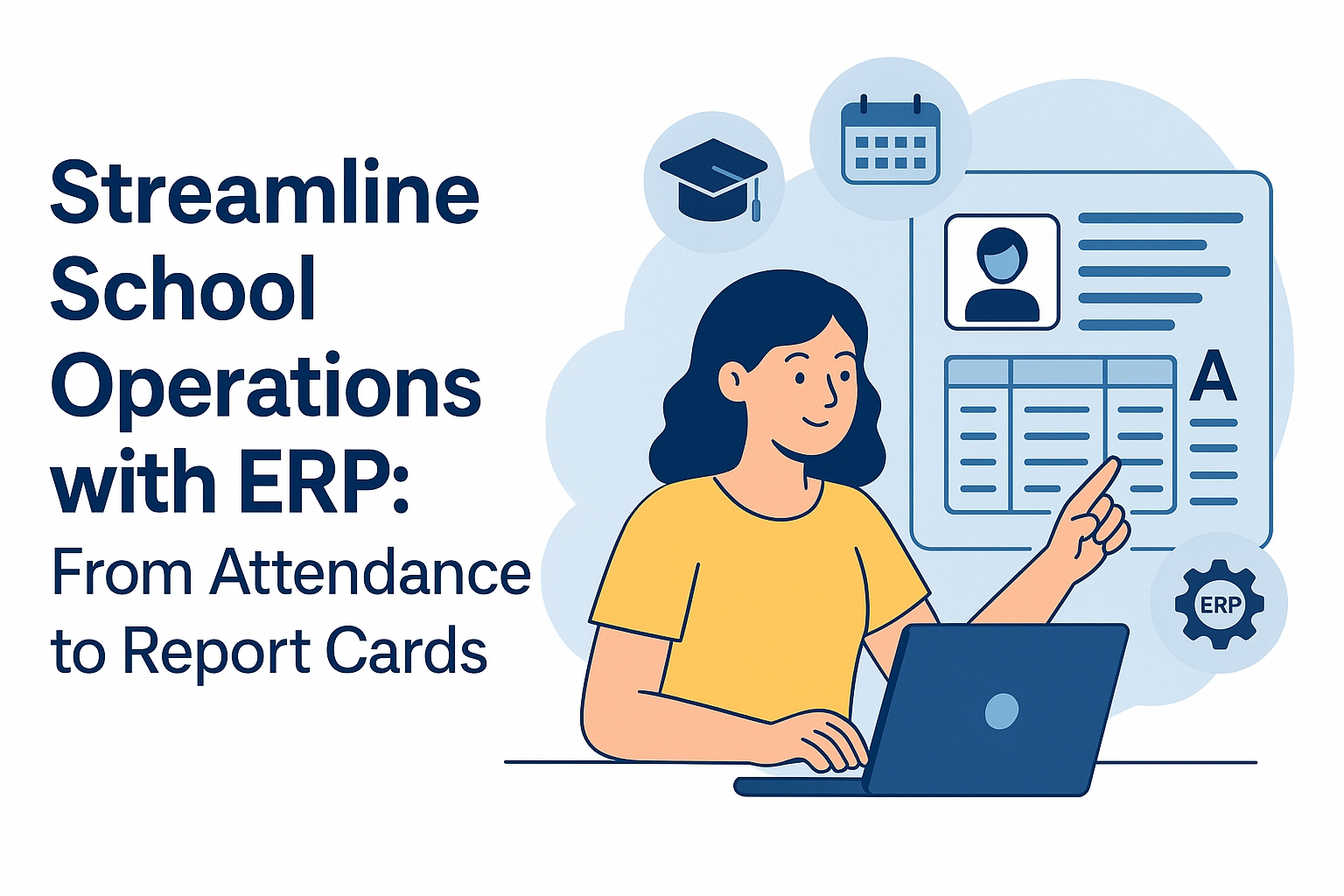
In today’s education landscape, school owners face immense pressure: delivering high-quality learning while keeping administrative costs low. Traditional management—relying on manual registers, fragmented systems, and disconnected processes—leads to inefficiencies, data inaccuracies, and poor decision-making. This is where School ERP (Enterprise Resource Planning) enters the picture, offering an integrated digital platform that transforms mundane tasks into actionable insights and streamlined workflows.
What is a School ERP System?
At its core, an ERP system is a suite of modules that manage key school functions—attendance, academics, finance, staff, communication, and more—via a central database, accessible anytime, anywhere. For schools, it means consolidating everything from student data to report cards in one cloud-based system. This integrated approach enables real-time tracking, automated reporting, and streamlined resource allocation, minimizing redundant work.
The Challenges of Manual School Management
Without ERP, school owners and administrators contend with:
Time-consuming paperwork and manual data entry prone to human error
Lack of real-time data, delaying informed decision-making
Fragmented systems, where attendance, exams, and fees live in silos
Weak communication channels, leading to misalignment
Difficulty scaling, especially for schools with multiple branches
These issues result in wasted resources, frustrated staff, and poor parent satisfaction.
Key ERP Modules That Make a Difference
1. Attendance Management
ERP simplifies attendance for students and teachers alike:
Digital roll calls via mobile or web apps reduce admin time
Real-time absence notifications to parents, improving engagement
Biometric/RFID integration ensures accuracy and security
Customizable reports—daily, weekly, by class or student—for performance tracking
Benefits include focused staff time, increased punctuality and accountability, and transparent oversight.
2. Timetable & Scheduling
Automatic timetable engines consider teacher availability, subject requirements, and room allocation. Updates are instantly visible to all—no more manual rescheduling.
3. Student Information System (SIS)
Centralized student profiles—encompassing grades, attendance, behaviour, assignments, fee status, and transport—allow quick retrieval and tracking across the academic lifecycle.
4. Exam Management & Report Card Module
Creating report cards with ERP is a breeze:
Automated grading using weightage-based or rubric evaluations
Subject-specific custom configurations, supporting CBSE, ICSE, or state boards
Secure result locking to prevent tampering
Instant publishing via parent portals or apps
Most importantly, a robust ERP enables the creation of a holistic report card that reflects not just academic scores, but also co-curricular and behavioral development—offering a 360° view of each student’s progress.
5. Fee & Finance Management
From invoicing to online payments and payroll, ERP systems provide:
Automated fee reminders and digital transactions
Expense tracking and financial reporting for budgeting and audits
Payroll automation, including tax and statutory compliance
The result? Financial transparency, fewer errors, and cost savings through reduced paperwork.
6. Communication Module
ERP platforms enable real-time, multi-channel communication:
SMS, email, or app alerts for attendance, grades, and school updates
Message and feedback portals to foster parent-student-teacher collaboration
Timely updates lead to better parental involvement and alignment among stakeholders.
7. Staff & Payroll Management
Manage staff lifecycle with tools for:
Leave tracking, attendance, and duty rosters
Automated salary calculations linked with biometric data
Efficient payroll processing, including PF, ESI, tax compliance, and payslips
Benefits of ERP for School Owners
Operational Efficiency
Routine workflows become automated, freeing up valuable staff time.Data-driven Decisions
Analytics dashboards help identify absenteeism trends, academic performance issues, and resource utilization.Enhanced Transparency
Everyone—parents, teachers, students, and administrators—has access to real-time insights.Cost Savings
Reduce paper use, storage needs, and redundancy in record-keeping.Scalability
Adding branches, new classes, or programs becomes seamless with cloud-enabled ERPs.Regulatory Compliance
Standardized financial modules and data protection features help meet audit and legal requirements.
Real-World Success Stories
Forward-thinking schools across the country have adopted ERP systems to eliminate manual reporting, reduce absenteeism, automate exam workflows, and improve parent satisfaction through consistent, transparent updates.
One standout example involves a group of private schools that replaced outdated grading systems with ERP-generated holistic report cards, enhancing the way teachers assess student personality traits, classroom conduct, and extracurricular achievements. This shift boosted parent engagement by 35% in one academic year.
Choosing the Right School ERP: A Checklist
Consider these features:
Cloud vs On‑Premises: Cloud-based ensures remote access and easier updates
Module Customization: Support for your board’s exam structure, fee plans, and attendance rules
Mobile Accessibility: Parent and student apps for real-time engagement
Integration Capabilities: Tie-ins with biometric hardware and learning platforms
Security & Compliance: Encryption, role-based access, and audit logs
Support & Training: Vendor onboarding, staff training, and ongoing updates are essential
Scalability & Cost: Look for subscription models based on user count and features
ERP Implementation Tips
Plan Change Management
Communicate benefits upfront to mitigate resistance.Train Staff
Hands-on sessions help buy-in.Pilot First
Start with one class/grade to gather feedback.Monitor & Iterate
Use analytics to refine modules regularly.Provide Ongoing Support
A dedicated team solves issues and drives adoption.
Future Trends for School ERP
AI & Predictive Analytics to forecast at-risk students or resource needs
LMS Integration for blended learning pathways
Gamification, digital badges, and feedback loops for student motivation
Mobile-First UX: intuitive apps for all stakeholders
Enhanced Data Privacy: GDPR‑like compliance, encryption, and audit trails
Conclusion
Evolving school operations requires a shift from manual silos to integrated, real-time digital systems. A well-implemented erp for schools :
Boosts efficiency across attendance, exams, finance, and communication
Drives data-informed decisions
Improves transparency, accountability, and parental trust
Saves costs through automation and reduced paper use
Scales seamlessly with your institution’s growth
More Useful Resources:
What Is a Holistic Progress Card? A Complete Guide for Educators and Parents
Top 5 School ERP Software Solutions in 2025: A Smart Guide for School Owners
What is a holistic report card? Benefits, features and implementation guide for schools
